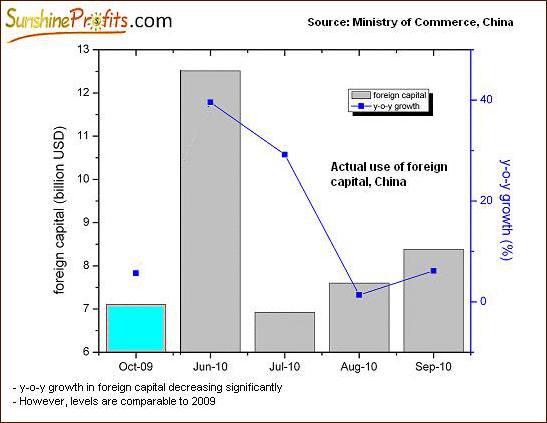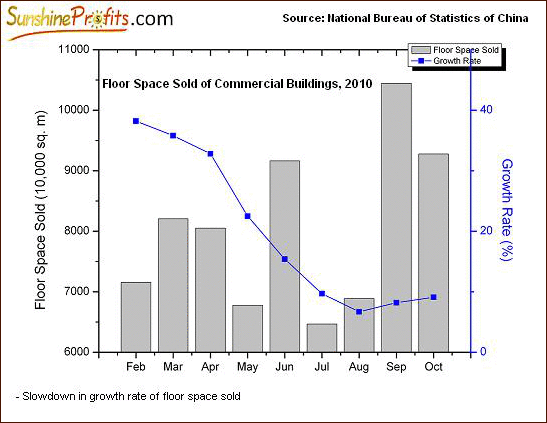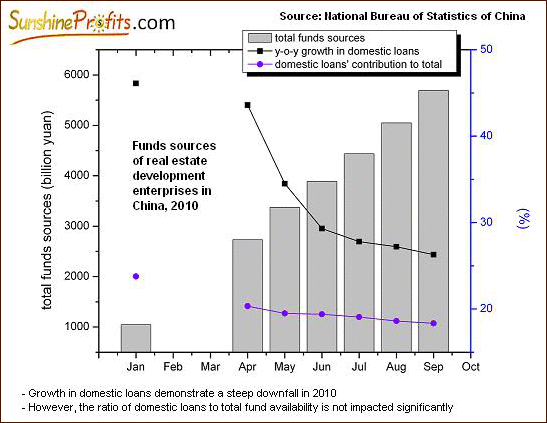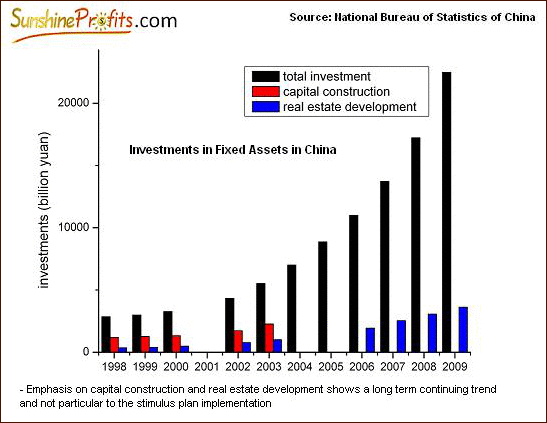Gold, Silver Impacts By China’s Infrastructure Building for Long-term Economic Growth
Commodities / Gold and Silver 2010 Nov 26, 2010 - 05:01 PM GMTBy: Mike_Stall
 In an earlier article we saw the might of China’s residential sector. An examination of the non-residential sector and infrastructure initiatives in China puts beyond doubt the support for metals from China alone. However, withdrawal of the effect of the stimulus combined with cautious investors expecting a correction in China’s real estate may result in an imminent correction before prices continue upward.
In an earlier article we saw the might of China’s residential sector. An examination of the non-residential sector and infrastructure initiatives in China puts beyond doubt the support for metals from China alone. However, withdrawal of the effect of the stimulus combined with cautious investors expecting a correction in China’s real estate may result in an imminent correction before prices continue upward.
The share of nonresidential construction is 27% of the total construction in China and growing at a fierce pace with more and more FDI flowing into the country. FDI has begun to dry up in anticipation of a slowdown in construction activities, but even at reduced levels construction in China is potent enough to support metal demand.

Bullish Signs for Non-residential and Infrastructure Activities
The non-residential and commercial construction sector in China witnessed a healthy growth rate in 2009, well above the world average. China still represents the fastest growing major national market in the world, despite a forecasted moderation in growth than experienced over the past five years. Expansion in the region will likely be boosted by a growing domestic economy, rebounding foreign investment funding, ongoing industrialization, efforts to expand and upgrade infrastructure, rising income levels and more population and household intensification.
Although nonresidential construction growth outperformed residential construction during the recession, it has slowed down considerably from the double-digit growth witnessed in the past few years. Generally, there is a lag of 12-18 months for nonresidential activity to reflect a slump in the residential market. Therefore, the upcoming six months could be critical to gauge the nonresidential construction sector. With a slowdown expected in the residential sector, a rub off of a possible bubble on the non-residential sector cannot be ruled out. As seen in the case of the residential sector, even at subdued levels, the size of the non-residential sector in China is adequate to propel base metal demand. The nonresidential construction sector absorbs nearly 6% of copper, aluminum, zinc and nickel – a significant global force worth analyzing.
The data for buildings completed and buildings under construction in the commercial sector in China have displayed resilience amid a slackening global construction sector in the recession. China’s biggest strength is its size – like a large portfolio gives an investor the opportunity to diversify well and absorb downsides better, China has so many infrastructure and capital construction avenues, that a downside in one area can be compensated by robust growth in another.
Improved consumerism over the past few years has led to a robust growth in commercial construction in China as reflected by the increase in shopping malls and other commercial buildings. The “commercial buildings floor space sold” data shows signs of a slowdown registering a growth of 8.2% in Sep10. The sharp plunge is a cause for concern, but such is the size of China’s construction sector that this is still well above the average growth observed in most developed economies.

A majority of the nonresidential construction space is accounted for by the commercial and the industrial sector. In 2010-11, construction in the institutional categories such as health, education and public safety is expected to be on course on the back of a continuing Chinese policy to emphasize on infrastructure. That is good news indeed because that overshadows a possible stagnation in the commercial category. What is also heartening to observe is that office vacancy rates have been arrested after a recovery in the economic situation. Demand for new office spaces have been revived consequent no further deterioration in unemployment rates.
Given the long term strength of China’s construction and infrastructure sectors, the growth story of industrial metals is intact. However, markets may react to the short-term trends of stagnation visible in China, leading to potential corrections in industrial metals’ prices. On the other hand, gold investments are not likely to be impacted by such market sentiments. If at all, regional gold demand in China is showing no signs of abatement. Commodity investors would take this cue and redistribute funds with more emphasis on precious metals and wait for industrial metals to bottom out before entering fresh long positions.
China better placed to tackle possible fund crunches
Improved bank lending, initiated in the downturn, has benefitted nonresidential construction, leading to the successful implementation of various commercial ventures. Short-term availability of funds may be hit as China tries to cool inflation and housing prices by compressing lending rates. However, the long term commitment of China towards higher loan availability is evident from the fact that Bank lending has been rising in recent months at an 18 percent rate compared with a year earlier, well after the economy has been put back on track and a further slump has been ruled out.
China will exercise stricter lending policies only in cases of hyper heating and inflation; otherwise it is committed to easier loan availability for new enterprises. Like in most areas, China’s fund sources are also well diversified. Domestic loan availability is not the only important factor determining construction growth. FDI investments also match bank lending when it comes to overall fund availability for commercial construction. Therefore, even in the case of stricter loan availability in the upcoming months, China may continue to do well if foreign investments hold up. Although, a scenario where both these sources dry up cannot be ruled out, the chances of all permutations playing against a growing construction sector is definitely lower than other nations where investment sources are limited.

China dictates metals demand with emphasis on infrastructure
Our analysis reveals that industrial metals, especially aluminum, copper and nickel are significantly influenced by the growth in the nonresidential construction sector in China. On moderate growth estimates in the next few years, the demand for base metals is likely to witness a growth of 1.5-3%, on an average. An aggressive growth estimate of 10-15%, if maintained, would revive the demand by 3 percent. Even in the worst case, China’s domestic consumption ensures growth rates in metal demand, fuelling prices.
The cornerstone of Chinese policies over the past decade has been its emphasis on infrastructure. China unveiled a USD 586 billion stimulus to boost infrastructure development at a staggering pace, clearly indicating that the construction sector will continue to support the demand for base metals. The impact of this stimulus is waning at present, but it is a signal to the global economy that China is committed towards investment in public infrastructure, which leads to future economic growth. A comparison of the US and Chinese stimulus programs shows the wide disparity in investments in infrastructure (and not printing money) - a contentious point that was analyzed and criticized in the recession.

The stimulus’ emphasis on infrastructure is not a one off policy from China - current numbers in key infrastructure sectors show that the growth story is intact even after the stimulus effect has cooled down. In fact, emphasis on construction has been an ongoing story in China for years. The investments in capital construction and real estate investments over the years have been comparable to that in the stimulus plan. After implementing the stimulus, China spent 4,191 billion yuan in infrastructure. While the huge amount China spent on infrastructure after unveiling the stimulus plan is noteworthy, it is perhaps interesting to note that even in 2003 (when total investments in fixed assets was a quarter of current levels) China had spent 2272 billion yuan on capital construction. Therefore, the ‘withdrawal of the stimulus’ effect is not as unfavorable to construction activities as is being perceived; certainly not in the long term.

In the current scenario, where Chinese authorities are striving to maintain economic growth, we believe that a 10-15% growth in the infrastructure is plausible even though the stimulus led infrastructure initiatives have begun to diminish. Public infrastructure growth is estimated at 15-20%, while nonresidential construction is pegged at an annual average of 9.7% until 2010-11. This will influence the global demand for industrial metals by approximately 2-3 percent. In fact, this figure is significant enough to counterbalance the entire demand slump for industrial metals due to the downturn in demand from the developed world.
Short-term Bears but Long-term Bulls for Metals
Signals from the Chinese construction sector appear mixed for the short-term. The long-term strength in the region has been established throughout this article. However, short-term trends often belly fundamentals and react to short-range numbers. Prices have begun to exert pressure on the real estate market but the Chinese government’s stress on infrastructure ensures downsides will be limited. China’s forward-looking planning process – infrastructure spending – is designed to spur overall domestic consumption, so there is no cause for serious concern.
While the Chinese government has implemented aggressive monetary and fiscal policy actions to re-engineer the construction sector, several factors will likely influence the sustainability of the recovery. The current level of lending that has its roots in an environment of economic uncertainty would be difficult to sustain for the upcoming years as China tries to cool its overheated engine. In addition, the strong FDI inflows during 2000-08 have reduced and could further ease, limiting the scale of infrastructure spending.
No significant improvement in unemployment rates in China would soon begin to weigh down consumer spending and slacken commercial ventures. All these factors suggest that the recent sharp recovery in the Chinese economy would moderate, leading to a correction in the short term. However, the government’s strategy to mitigate the impact of the slowdown through spending on infrastructure and public utilities is expected to be the key factor supporting demand for industrial metals.
Overall, analysis of the Chinese construction sector in conjunction with fundamentals indicates a correction in industrial metals prices in the near-term. Although, some support can be envisaged from the Chinese construction sector, the overall trend could be negative for some time. On the higher side too, the current sharp recovery in China is expected to increase caution among investors, as prices edge upward.
As the negative factors outweigh the positive ones, we maintain an interim bearish outlook for the base metals complex. Investors seeking to enter fresh long positions (with a 1-2 year horizon) in industrial metals might want to wait for a correction of 5-10% from the current levels. Also, investors holding long positions are advised to book partial profits at any rise from the current levels.
However, the key point is that long-term fundamentals are intact. The Chinese government’s initiative to boost domestic consumption holds the key to the demand for metals in the future. The economic rebalancing of China, from an export driven economy to a domestic consumption-led one, is crucial to the overall recovery in the economy and, in turn, the demand for industrial metals. So, investors should consider any correction as a great buying opportunity.
Investors should realign portfolios replacing industrial metals with precious metals in the short term. Precious metals, particularly gold demand in China is expected to hold strong even in the event of a temporary stagnation in Chinese construction activities. Investments in precious metals alongside industrial metals also provide appropriate balance to any commodity portfolios. This is something similar to growth and value stock mixtures that equity portfolio advisors favor. Metals are growth investments that come with interim downsides while precious metals are value investments where the downside risk is limited (and growth is certainly not capped in the current environment). That will most likely be the case until we are in the third stage of the bull market, when the public focuses mainly on gold and silver - just like it was the case during the final stage of the bull market 30 years ago. At that time, we expect precious metals to substantially outperform other investment classes including industrial metals.
If you are interested in knowing more on the market signals we analyze, we encourage you sing up for our free mailing list - if you sign up today, you'll get 7 days of full access to our website (Premium Updates, Charts, and Tools) absolutely free. In other words, there's no risk, and you can unsubscribe anytime.
Thank you for reading.
Mike Stall
Sunshine Profits Contributing Author
Sunshine Profits
Mike Stall is a writer on SunshineProfits.com. He is a commodity analyst in the precious and industrial metals space with a background in quantitative analysis of the financial markets. Mike Stall has been actively associated with studying gold, silver and base metal prices from both a quantitative as well as a fundamental standpoint. Mike Stall believes that commodities are superior investment instruments in comparison with most other asset classes as they tend to perform better in environments of inflation, fluctuating currencies and uncertain equity markets.According to him, the inherent and intrinsic value of a commodity often leads to safer and stronger returns that have been historically proven, fundamentally as well as quantitatively.
Interested in increasing your profits in the PM sector? Want to know which stocks to buy? Would you like to improve your risk/reward ratio?
Sunshine Profits provides professional support for precious metals Investors and Traders.
Apart from weekly Premium Updates and quick Market Alerts, members of the Sunshine Profits’ Premium Service gain access to Charts, Tools and Key Principles sections. Click the following link to find out how many benefits this means to you. Naturally, you may browse the sample version and easily sing-up for a free trial to see if the Premium Service meets your expectations.
All essays, research and information found above represent analyses and opinions of Mr. Radomski and Sunshine Profits' associates only. As such, it may prove wrong and be a subject to change without notice. Opinions and analyses were based on data available to authors of respective essays at the time of writing. Although the information provided above is based on careful research and sources that are believed to be accurate, Mr. Radomski and his associates do not guarantee the accuracy or thoroughness of the data or information reported. The opinions published above belong to Mr. Radomski or respective associates and are neither an offer nor a recommendation to purchase or sell securities. Mr. Radomski is not a Registered Securities Advisor. Mr. Radomski does not recommend services, products, business or investment in any company mentioned in any of his essays or reports. Materials published above have been prepared for your private use and their sole purpose is to educate readers about various investments.
By reading Mr. Radomski's essays or reports you fully agree that he will not be held responsible or liable for any decisions you make regarding any information provided in these essays or reports. Investing, trading and speculation in any financial markets may involve high risk of loss. We strongly advise that you consult a certified investment advisor and we encourage you to do your own research before making any investment decision. Mr. Radomski, Sunshine Profits' employees and affiliates as well as members of their families may have a short or long position in any securities, including those mentioned in any of the reports or essays, and may make additional purchases and/or sales of those securities without notice.
© 2005-2022 http://www.MarketOracle.co.uk - The Market Oracle is a FREE Daily Financial Markets Analysis & Forecasting online publication.



